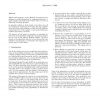Free Online Productivity Tools
i2Speak
i2Symbol
i2OCR
iTex2Img
iWeb2Print
iWeb2Shot
i2Type
iPdf2Split
iPdf2Merge
i2Bopomofo
i2Arabic
i2Style
i2Image
i2PDF
iLatex2Rtf
Sci2ools
JFP
2002
2002
Secrets of the Glasgow Haskell Compiler inliner
Higher-order languages, such as Haskell, encourage the proto build abstractions by composing functions. A good compiler must inline many of these calls to recover an e ciently executable program. In principle, inlining is dead simple: just replace the call of a function by an instance of its body. But any compilerwriter will tell you that inlining is a black art, full of delicate compromises that work together to give good performance without unnecessary code bloat. The purpose of this paper is, therefore, to articulate the key lessons we learned from a full-scale production" inliner, the one used in the Glasgow Haskell compiler. We focus mainly on the algorithmic aspects, but we also provide some indicative measurements to substantiate the importance of various aspects of the inliner.
| Added | 22 Dec 2010 |
| Updated | 22 Dec 2010 |
| Type | Journal |
| Year | 2002 |
| Where | JFP |
| Authors | Simon L. Peyton Jones, Simon Marlow |
Comments (0)

